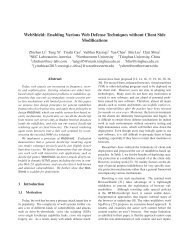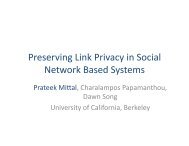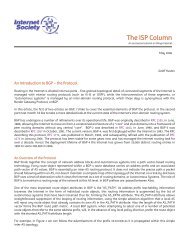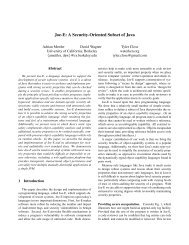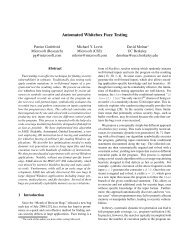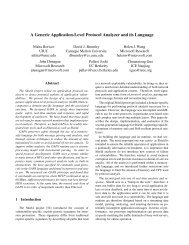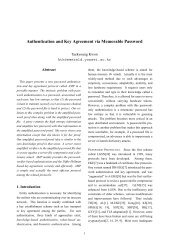Slides
Slides
Slides
Create successful ePaper yourself
Turn your PDF publications into a flip-book with our unique Google optimized e-Paper software.
Client Puzzles<br />
A Cryptographic Defense Against Connection<br />
Depletion Attacks<br />
Ari Juels and John Brainard<br />
RSA Laboratories
Connection Depletion:<br />
The Problem
How to disable a restaurant<br />
Restauranteur<br />
Saboteur
Table for four<br />
at 8 o’clock.<br />
Name of Mr. Smith.<br />
O.K.,<br />
Mr. Smith<br />
Restauranteur<br />
Saboteur<br />
Saboteur vs. Restauranteur
Restauranteur<br />
Saboteur<br />
No More Tables!
An example: TCP SYN flooding<br />
“TCP connection, please.”<br />
Server<br />
“O.K. “O.K. Please send send ack.” ack.”<br />
Client<br />
Buffer
◆ TCP SYN is a real-world problem<br />
– Panix, mid-Sept. 1996 (NYT)<br />
– New York Times, late Sept. 1996<br />
– Others<br />
◆ Similar attacks may be mounted against<br />
e-mail, SSL, etc. -- resources other than<br />
memory
Some defenses against<br />
connection depletion
IP Tracing (or Syncookies)<br />
Client<br />
Server<br />
Hi. My name is<br />
10.100.16.126.<br />
Request<br />
Problems:<br />
Buffer<br />
•Can be evaded, particularly on, e.g., Ethernet<br />
•Does not allow for proxies, anonymity
Digital signatures<br />
Client<br />
Server<br />
Buffer<br />
Problems:<br />
•Requires carefully regulated PKI<br />
•Does not allow for anonymity
Connection timeout (for buffers)<br />
Server<br />
Client<br />
Problem: Hard to achieve balance between security<br />
and latency demands
Throw away requests at random<br />
Client<br />
“Hello”<br />
“Hello”<br />
Server<br />
“Hello”<br />
Buffer<br />
Problem: Legitimate clients must keep retrying in<br />
high volume attacks
Our solution: client puzzles
Intuition<br />
<br />
Table for four<br />
at 8 o’clock.<br />
Name of Mr. Smith.<br />
Please solve this<br />
puzzle.<br />
O.K., O.K.<br />
Mr. Smith<br />
Restauranteur
Intuition<br />
Suppose:<br />
◆ A puzzle takes an hour to solve<br />
◆ There are 40 tables in restaurant<br />
◆ Reserve at most one day in advance<br />
A legitimate patron can easily reserve a table,<br />
but:
Intuition<br />
<br />
<br />
<br />
<br />
<br />
<br />
Would-be saboteur has too many puzzles to solve
The client puzzle protocol<br />
Client<br />
Service request R<br />
Server<br />
O.K.<br />
Resource
Remarks<br />
◆ Can use puzzles for any type of<br />
resource<br />
◆ Only have to distribute puzzles when<br />
under attack<br />
◆ Can scale hardness of puzzles<br />
depending on severity of attack
What does a puzzle look like
Puzzle basis: partial hash inversion<br />
<br />
pre-image X<br />
partial image X’ <br />
k bits<br />
160 bits<br />
hash<br />
image Y<br />
Pair (X’, Y) is k-bit-hard puzzle
Puzzle construction<br />
Client<br />
Server<br />
Service request R<br />
Secret S
Server computes:<br />
Puzzle construction<br />
secret S time T request R<br />
hash<br />
pre-image X<br />
Puzzle<br />
hash<br />
image Y
Puzzle properties<br />
◆ Puzzles are stateless (client provides T<br />
and R with puzzle)<br />
◆ Puzzles are easy to verify<br />
◆ Hardness of puzzles can be carefully<br />
controlled<br />
◆ Puzzles use standard cryptographic<br />
primitives
Where to use client puzzles
Some pros<br />
Avoids many flaws in other solutions, e.g.:<br />
◆ Allows for anonymous connections<br />
◆ Does not require PKI<br />
◆ Does not require retries -- even under<br />
heavy attack
Drawback<br />
◆ Requires special-purpose software,<br />
e.g., browser plug-in
Client puzzles seem most suitable for internal<br />
networks<br />
Candidate technology for RSA/Security Dynamics<br />
enterprise security servers
Conclusions
What’s in the paper<br />
◆ Introduces idea of puzzles for on-the-fly<br />
resource access control<br />
◆ Detailed puzzle and protocol description<br />
◆ Discussion of overhead<br />
– How long to process puzzle solution<br />
– How many extra tables
Too<br />
◆ Rigorous mathematical treatment of<br />
parameterization/security level<br />
– Solving puzzles is a probabilistic process --<br />
attacker may get lucky<br />
◆ Protocol can be simplified and made<br />
more efficient
More work on puzzles<br />
Puzzles have also been proposed for:<br />
◆ Controlling spam (DN94, BGJMM98)<br />
◆ Auditing server usage (FM97)<br />
◆ Time capsules (RSW96)
More to be done<br />
◆ How to define a puzzle Search space<br />
vs. sequential workload<br />
◆ Can puzzle construction be improved<br />
– Replace hash with, e.g., reduced-round<br />
cipher<br />
◆ Can puzzles be made to do useful<br />
work
Questions<br />
e-mail: ari@rsa.com




